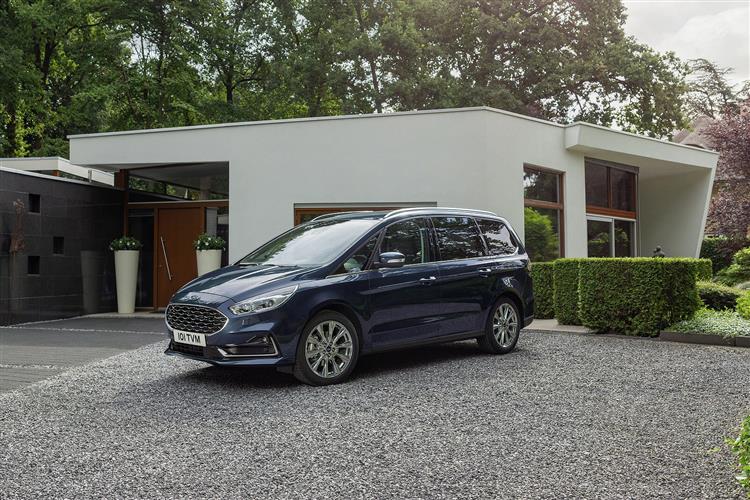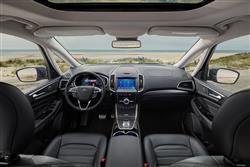How will you view?
This is a sample, showing 30 seconds of each section.
A GALAXY OF SEATING OPTIONS (some text hidden) SECTIONED_new_fordgalaxy_2016
BY JONATHAN CROUCH
Introductionword count: 111
You buy a Ford Galaxy focusing on practicality, but this large seven-seater MPV has many other virtues in this third generation CD390-series post-2015-era guise. There's excellent refinement, useful driver assistance technologies and versatile interior innovations that'll make family life easier. Plus a reasonably efficient engine range that could see you running one of these with the kind of frugality and cleanliness you'd expect from a conventional medium range estate. One thing didn't change with this MK3 model though: unlike more compact seven-seat models of the 2016-2023 period, adults can sit comfortably in the third row. A Galaxy should, after all, prioritise space. Let's check this car out as a used buy.
Modelsword count: 17
five-door MPV - (1.5, 2.0 petrol, 2.5 petrol Hybrid, 2.0 TDCi diesel [Zetec, Titanium, Titanium X] )
Historyword count: 539
Once upon a time, Ford's Galaxy was the kind of thing you meant when talk turned to big People Carrying MPVs. A large seven-seater with three rows of seats and proper room for fully-sized adults in all of them. By 2015 and the launch of the CD390-series design we look at here though, most MPVs weren't like that. Still, if this is still your idea of People Carrying perfection, then Ford's MK3 Galaxy is a used car contender you can't afford to ignore. Back in 2015, the Blue Oval band was offering the widest selection of MPVs in the industry - everything from the supermini-based B-MAX at one end of the scale to the enormous nine-seater Tourneo Custom at the other. The seven-seat line-up started with the car-like Grand C-MAX and the van-based Tourneo Connect, but for third row seating properly capable of regularly accommodating adults for longer distances, families needed the company's large segment Mondeo-based S-MAX and Galaxy models, both re-launched in mid-2015. These two cars were virtually identical beneath the skin but in the showroom, they were aimed at very different kinds of customers. The sportier, more dynamic S-MAX was a little cheaper and a little smaller inside than this Galaxy, hence its market positioning slightly closer to seven-seat MPVs of the period like Renault's Grand Scenic and Vauxhall's Zafira Tourer (derived from more compact designs). In contrast, this more practical Galaxy's boxier shape gave it significantly more rearward passenger space than cars of that sort. Instead, it more naturally competed with unapologetically large People Carriers of the period like Volkswagen's Sharan and SEAT's Alhambra - the two rivals that had shared this Ford model's design in its first generation of life, following the Galaxy's original launch back in 1994. The shared development approach certainly served its purpose in the early stages of the life of this model line, laying the groundwork for sales figures that by 2006 were seeing over three-quarters of a million Galaxys pounding global roads. By 2006 though, the Blue Oval brand had decided it could do better alone, launching the MK2 Galaxy, a better-handling product that allowed buyers to get a lot in without having to check all the seats out. That second generation version was updated with a more modern engine range in 2011, but by 2015 was starting to show its age when it came to issues of running cost efficiency, technology, safety and connectivity. Hence the need in 2015 for the MK3 model line-up we're going to look at here, a range with more segment-leading electronics and one that also included an AWD option to potentially tempt family buyers who might have been looking at seven-seat SUVs. Plus it claimed to be just as spacious and even more practical than its appealing predecessor. The CD390-series Galaxy got a mid-term facelift in 2020, which bought a fresh front grille and bumpers to match the look of smaller Ford models. A top 'Vignale'-spec version was also introduced, along with a redesigned automatic transmission and an updated infotainment screen with 'Apple CarPlay' and 'Android Auto'. A 2.5-litre Duratec petrol Hybrid engine was introduced in late 2021 replacing the diesel versions. The Galaxy was eventually dropped from the price lists in late 2023.
What You Getword count: 472
You wouldn't expect this fourth generation Galaxy to look especially dynamic. Ford did, after all, offer a comparably-sized S-MAX MPV if that's what you want. It should though, appear modern and purposeful - or, to use Ford terminology, 'contemporary' and 'sophisticated'. Most potential buyers will probably think that it does. Behind the wheel, this car's vast glass area combines with the slim windscreen pillars to create excellent all-round visibility, plus it's easy to find the ideal driving position thanks to the considerable amount of seat and wheel adjustment provided and the way the headrests go forward and back as well as up and down. Ahead of you through the leather-trimmed three-spoke multi-function steering wheel, there's a clear, classy instrument cluster that in mid and upper-range models gives you a quite sophisticated 10.1-inch TFT set-up made up of various inset multi-function displays. Anything this set-up can't tell you will probably be covered by the feature that on all models dominates the centre of the dash, the 8-inch SYNC 3 colour touchscreen, there to play its part in reducing button clutter and giving the cabin a cleaner, smarter feel. What about when you move rearwards? Well we'll start in the middle row. Here, you'll find that the three individual seats provided do most of what MPV buyers would expect them to do, sliding back and forth and reclining for greater comfort on longer journeys. The third row is a little more easily accessible than it was on the previous model thanks both to a recessed floor design and the 'Easy-Entry' one-touch mechanism that tilts and slides the seat forward, up and out of your way. It's at this point that you'll cash in on this car's extra size. The boxy shape delivers significantly more headroom than you'd get in an S-MAX. As a result, in a Galaxy, you can use the seats back here for adults on longer trips. On to boot space. When all the seats are upright in this Galaxy, you get 300-litres to play with, 15-litres more than is provided by the S-MAX. In this Ford, these extra rearmost seats fold neatly into the floor and can do so with electrical assistance. Once the two chairs are retracted, up to 1,301-litres of space is freed up (336-litres more than you'd get in an S-MAX) and can be covered by a useful reversible/foldable loading mat which came included in the optional 'Family Pack'. For ultimate carriage capacity, you can of course fold forward the individual middle row chairs. In all Galaxy models, these seats are flattened electrically and once you've got used to this, it's a rather nice feature to have, making it a little annoying that you'll always have to raise them back up manually. Anyway, once the middle row is flat, it frees up a vast area, 2,339-litres in size.
To see the full road test text contact us on 0330 0020 227
Pictures (high res disabled)

.jpg)
|
.jpg)
|
.jpg)
| |||
.jpg)
|
.jpg)
|
.jpg)
| |||
.jpg)
|
.jpg)
|

|
Scoring (subset of scores)
Category: MPV People Carriers
| Performance | |
| Handling | |
| Comfort | |
| Space | |
| Styling, Build, Value, Equipment, Depreciation, Handling, Insurance and Total scores are available with our full data feed. | |





